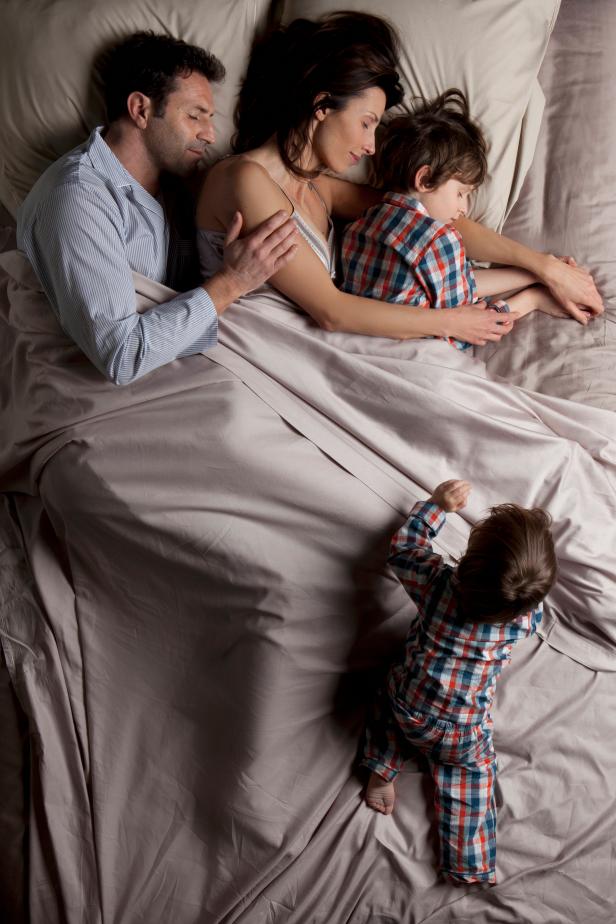Here’s How to Create a Better Sleep Routine for Everyone in Your House
Revamp your sleep routines for the new year.


Vincent Besnault
A great night’s sleep can leave you feeling refreshed and ready to take on the world. However, bad sleep, especially many nights of bad sleep, can wreck your whole day. So, if you are looking to scoot everyone off to bed earlier and hoping your whole family snoozes longer, here are a few ways to improve your family’s sleep and make everyone’s days and nights a little better.
What’s the Magic Number?
At different ages, we require different hours of sleep. So, if you don’t know how long everyone should be snoozing, there’s a chance your family is missing out on critical sleep time. Here’s how much sleep everyone should be getting according to the National Sleep Foundation.
Newborn, 0-3 months old: 14-17 hours
Infant, 4-11 months old: 12-15 hours
Toddler, 1-2 years old: 11-14 hours
Preschool, 3-5 years old: 10-13 hours
School-age, 6-13 years old: 9-11 hours
Teen, 14-17 years old: 8-10 hours
Young Adult, 18-25 years old: 7-9 hours
Adult, 26-64 years old: 7-9 hours
Older Adult, 65+: 7-8 hours
Make Some Upgrades to Your Bedrooms
We’re not talking about adding fancy furniture or chic decor to your bedroom. If you are making upgrades to everyone’s bedroom, make it count. From making sure everyone has a high-quality mattress, pillow and bedding to adding blackout curtains to the windows to help keep out those pesky rays that can keep you up or wake you up, set the mood in your room by upgrading the items that will help everyone sleep.
Keep It Cool
Research suggests there is an ideal temperature that we should set our bedrooms to in order to get the best sleep–65 degrees. So set the thermostat to 65 and don’t touch it. Being too hot or too cold can interrupt our sleep at night, but 65 is cozy and will send you off to dreamland.
Set a Schedule and Stick to It
Now that you know how much sleep everyone in your house needs and your bedrooms have been optimized for sleep, it’s time to get serious about planning your day and night around getting rest. Set a bedtime for everyone and a wake time. It can be tempting to stay up later on the weekends but try to stick to the same sleep schedule even on the weekends.
Ditch Technology
From TVs in the bedroom to scrolling on your phone or catching a show on your tablet while you lounge on the couch or in bed, too much technology in the evening can be the reason it’s so hard to fall asleep and stay asleep. The lights from your screen can disrupt your body’s ability to produce melatonin (the hormone that helps you sleep), and the alerts from your phone and tablet can interrupt your sleep late at night. So set a time when all screens have to be off and keep technology out of the bedroom.
Have a Sleep Routine
Creating a sleep routine for babies is easy–bath, books, snuggles and sleep–but everyone in your house should have their own sleep routine. This routine will prep your mind and body for rest and help ease everyone into sleep. Create a routine that works for you and help your kids develop their own sleep routine.
Powernap, but Be Careful
Naps are essential for babies and toddlers but for adults, a nap can refresh you or wreck your sleep that night. So, if you are trying to sneak in a nap, make sure it’s no longer than 20 minutes and aim to nap in the early afternoon.
Opt for an Earlier Dinner
Doctors recommend that you eat dinner at least four hours before you head to bed. So, if this means adjusting dinner, do that instead of adjusting bedtimes.
Break a Sweat During the Day
Exercise in the daytime leads to better sleep at night. So, if you can’t sneak in a workout, try a family walk or stream a workout in your home. Try to get your exercise in the morning or early afternoon so that it doesn’t interrupt your winddown time or bedtime.















